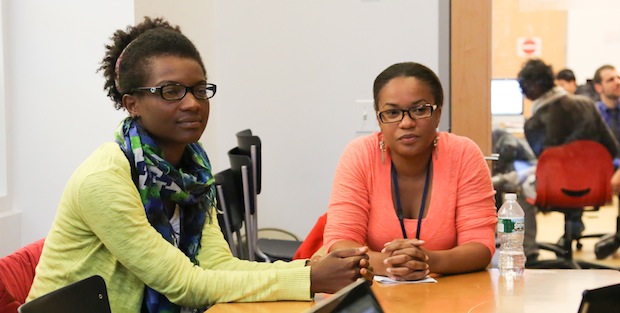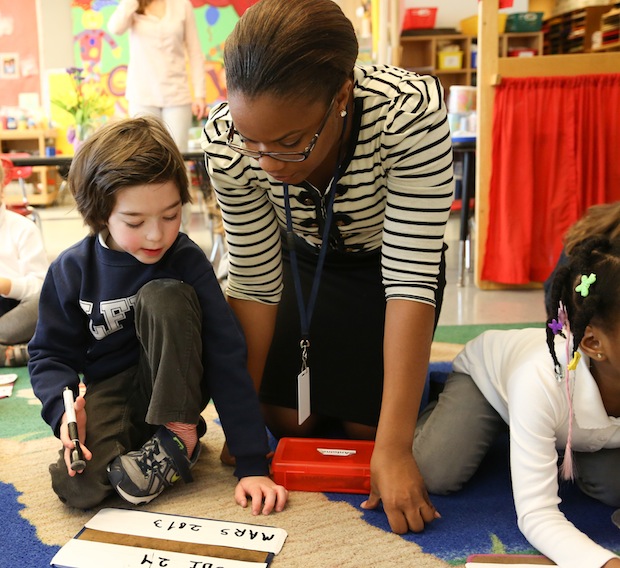Alexandra René visits a kindergarden class at the Lycée Francais de New York, March 21 2013.
Q: What is the goal of your visit to our school this week?
A: We are teachers from a school in Haiti that has a partnership with the LFNY and we are trying to gather as much information as possible to bring back to the school in Haiti, Lycee Jean-Baptiste. We’re doing this because we do need a lot of resources and a lot of help in teaching and what other ways we can teach and helping even the Haitian teachers, changing their teaching methods, so pretty much we’re just gathering everything we can to improve conditions in the school.
What type of school is this and where is it located? Was it near the epicenter of the 2010 earthquake?
The school located in St. Marc, which is a city in the north of Haiti that was not really affected by the earthquake. The school is only about 2 years old and we have kids to age 3 to 6 (so the grades go up to CP), with about 200 children total (25 per class with two classes per grade) and every year the founders will integrate a new grade until we get to 12th grade. The school is open mostly to children from impoverished backgrounds.
The school was built after the earthquake. Why did you choose St. Marc over, say, Port-au-Prince?
We decided not to go to Port-au-Prince because it’s already a big city and they already have a lot of schools. I think also after the earthquake, before they could start working on Port-au-Prince they wanted to start working outside, because even before the earthquake it was still a third-world country with a lot of issues, so they wanted to start off working outside of Port-au-Prince and maybe work their way towards there later on. The reason why the founders picked St. Marc specifically was because they wanted to find an area that really needed their help, and St. Marc, that area is one of the poorest in Haiti. They wanted to make sure that they were really making a difference.
What is the Lycee’s involvement in the partnership with the school?
The reason why the school was built was because of the earthquake. Right after the earthquake was when the founders wanted to do something to give back to the community and they said that they did a lot of research and that there were a high percentage of uneducated Haitians and that one good way of helping out was to build a school to educate people, and they started building the school 8 months after the earthquake.
The Lycee helped provide us with training, to develop the teaching methods we’re using because we have a similar system that you use here, teaching in French and in English, and they help with the French program mostly. We have Lycee teachers come sometimes and show us how to implement teaching methods in the classroom.
What does the school have access to?
We do have some materials, but we can’t say that we are well equipped, like we need everything that we can get. We need more educational toys to have hands-on activities for the kids, for example. At the beginning of the year we have a set of materials but after the year ends it finishes, so at the end of every year we need to find new material. Kids can also get bored when they use the same materials all the time and so that’s where we need more materials throughout the year.
What language is the teaching done in?
The kids learn English and French, it’s pretty equal. We do one day teaching in French and one day in English, trying to help them be bilingual. Each class has two teachers – one English and one French one, and both teach subjects like science and math in the two different languages. Some subjects are more particular – we do history mostly in French because it’s the history of Haiti that they’re learning,
How involved are parents?
We want parents to encourage their children as much as possible because that really teaches them that education is important. There is a certain percentage of parents though who can’t even sign their child’s report card, so we have our social worker communicate verbally with them because it is important that they know what’s going on in school and with their son or daughter’s education.
Do kids have homework to do outside of the classroom?
We did start giving homework recently, and only recently because we were afraid it would be too difficult for kids to do it because parents wouldn’t be able to help them, especially with the English parts. So we help, and I give parents my number so that they can call me over the weekend if their children need help. We give homework based on what we learned in class so there’s no new material, so it shouldn’t be that difficult for kids.
What does the school offer outside of the classroom?
The kids have recess and play a lot of soccer on a little field. We don’t have a lot but the kids are creative and come up with a lot of games to keep themselves busy. The school also has after-school activities with Haitian teachers or animators that come and do more relaxed and fun activities with the kids – so either dance, singing, painting, things like that. These teachers also speak Creole to the kids so they feel more comfortable.
What are a few of the major issues within the school?
The lack of materials is definitely an issue. Also even though we have one smartboard, and a few computers, we do have problems with electricity and air conditioning. We do have a generator but when the electricity just shuts down, it does take some time to get power back. We’re still working on stability, trying to get a strong team of teachers, get a strong foundation.
Who are the founders and what is their connection with Haiti and wanting to build a school in St. Marc?
First, there’s Ed Brennan who is the CEO of Duty Free, and Olivier Bottrie, President of Estee Lauder, wanted to give back to the community, and who is married to a Haitian woman who encouraged him to get involved and build a school. They have many contacts with private companies who donate to the school, so with all those factors put together they decided to build a school in Haiti.
What types of funding does the school receive? What does the government provide?
We get funding from a variety of places, from everywhere around the world – Dubai, France, the US, China, we get a little bit of funding from everywhere. The government provided us with the land for free, they donated space to the organization so the school could be built. We also get a lot of materials donated to us, not just money, things like books to create a library, smartboards… In the future we plan to advertise the school more to get more funding and be able to buy more materials.
You mentioned that the school is mostly open to children from impoverished backgrounds. How is that measured and who has access to the school?
We have a social worker who has a list of children in poorer neighborhoods of St. Marc and who goes out into the community and into these neighborhoods to check on these kids and try to give them priority. We have buses to transport them to and from school so they never have to worry about living too far away and are able to come to school. We try to have about 80% of the kids from underprivileged backgrounds but also 20% from less impoverished families in order to create a mixture, have some diversity.
What are your personal involvements in this school and your connections with it?
We live on the school’s campus and we teach all subjects in English. We don’t just teach one subject because once again it is a third world country, and like I said earlier that area is very poor. So when the kids come in our classroom it’s a totally different world for them. Once they go back out of that classroom and school’s over, they’re back into another world. So, it’s not just teaching a subject we are teaching them a whole lot more. I was born and raised in Brooklyn, New York. My family is from Haiti, but last year was the first time I ever went to the country. I always wanted to go and teach there but I was afraid because of all the issues in the country. The media often exaggerates the problems and leaves out the good parts But finally going there and being able to teach was like a dream come true. Now I’m able to really see the issues instead of just hearing about them, and really make a difference with the young ones who can really change Haiti for the better in the future.
—
For more information, you can visit this website: http://www.handinhandforhaiti.com/index.html
About the Author :
Andrea is a Y12 student (Terminale ES) at the Lycée Francais de New York. It is her 5th year there. She is the news editor of the student publication The Lynx and passionate about history, economics, and tennis.


